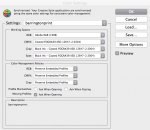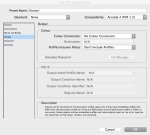andy_baz
Member
Good Afternoon,
Background Info
I am pre-press originator with 15 years experience in the trade but only recently trying to achieve a (properly) color managed workflow.
I create print jobs in InDesign for out putting to our printing presses. Presses being A Komori lithrone 26 and a Sanxin YK524.
On both presses we run full colour jobs on both coated and uncoated stocks.
My Workflow
From Indesign i Export PDF's into our Momentum workflow(which i believe is a harlequin RIP badged as Momentum RIP).
In the Momentum workflow i have 2 print queues for each press: Coated and Uncoated.
Both presses run a two curve operation (rightly or wrongly il'll let you decide) with the plates being linearized and then adjustments added as per the Intended and Actual Curve settings.
The intended curve for Coated is FOGRA 39 ISO A Standard
The intended curve for Uncoated is FOGRA 29 ISO B Standard
The actual curves have been produced from linear plates and dot gain values entered accordingly.
Should i convert job/PDF to desired out color profile before sending to RIP or not...?
By this i mean before pacing my pdf into the workflow should i be converting the pdf to the intended profiles?
For example my InDesign colour management destination settings are set FOGRA 39 Coated jobs, so im wondering if for Uncoated jobs should i be manually Converting the PDF to the FOGRA 29 profile then placing into my workflow Uncoated print queue ready for outputting plate?.
I currently exported unconverted PDF's fro indesign and let the RIP adjust the values accordingly for each queue but im not sure if this is correct.
I hope i have explained this correctly and have covered all areas i need to, feel free to ask for more information
I eagerly await your answers and opinions, and will be very grateful to those who respond.
Andrew Barrington
Background Info
I am pre-press originator with 15 years experience in the trade but only recently trying to achieve a (properly) color managed workflow.
I create print jobs in InDesign for out putting to our printing presses. Presses being A Komori lithrone 26 and a Sanxin YK524.
On both presses we run full colour jobs on both coated and uncoated stocks.
My Workflow
From Indesign i Export PDF's into our Momentum workflow(which i believe is a harlequin RIP badged as Momentum RIP).
In the Momentum workflow i have 2 print queues for each press: Coated and Uncoated.
Both presses run a two curve operation (rightly or wrongly il'll let you decide) with the plates being linearized and then adjustments added as per the Intended and Actual Curve settings.
The intended curve for Coated is FOGRA 39 ISO A Standard
The intended curve for Uncoated is FOGRA 29 ISO B Standard
The actual curves have been produced from linear plates and dot gain values entered accordingly.
Should i convert job/PDF to desired out color profile before sending to RIP or not...?
By this i mean before pacing my pdf into the workflow should i be converting the pdf to the intended profiles?
For example my InDesign colour management destination settings are set FOGRA 39 Coated jobs, so im wondering if for Uncoated jobs should i be manually Converting the PDF to the FOGRA 29 profile then placing into my workflow Uncoated print queue ready for outputting plate?.
I currently exported unconverted PDF's fro indesign and let the RIP adjust the values accordingly for each queue but im not sure if this is correct.
I hope i have explained this correctly and have covered all areas i need to, feel free to ask for more information
I eagerly await your answers and opinions, and will be very grateful to those who respond.
Andrew Barrington
Last edited by a moderator:
















